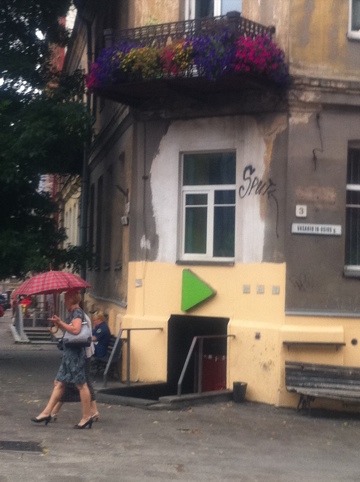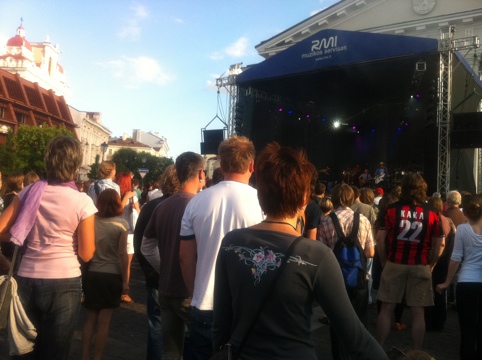Museums by day…
Because the day’s forecast was for rain, we decided to plan indoor activities and set an agenda that included museum visits. We set out into the cool, grey morning after another breakfast of blynai, eggs and sausage at the hotel.
The first stop we planned was the Genocide Museum, so we headed up out of the old city and onto Pamelninko gatve. When we turned on Auko gatve for the museum, we saw a couple small groups of people milling around outside and pulling on the door. A quick look at the door revealed that the Museum was closed on Tuesdays as well as on Mondays. And what the people waiting didn’t realize is that the graphic on the door indicating closure on the first two days of the week meant Monday and Tuesday, not Sunday and Monday. Lithuania, as well as some other European nations, begins its week on Monday–the name for the day gives you the clue: Pirmadiena, or first day.
So we cut over to Gedimino prospectas, which would lead back down to the Lithuanian National Museum. The exhibit on the Grand Duchy of Lithuania from the 13th to 18th century was a great overview, and saved me from passing along misinformation in reply to Alex’s questions about Lithuanian history. Among the Polish/Lithuanian rulers in the 1700s we came across a Lesczynsky, which is the last name of one of Alex’s friends at home. Tons of awesome maps, chronicling those ever-changing borders.
Moving on, we tried to imagine our ancestors living in the farmhouse rooms and wearing the clothing feature in the Rural Lifestyle in Lithuania exhibit. I loved the brightly and intricately painted chests and wardrobes. The textiles were stunning as well.
I love folk art, so I really got into the Lithuanian Cross-work exhibit. A short documentary film helped put context around the elaborately carved crosses and shrines that used to fill the countrysides and forests. There was a huge collection of carved saints that I would have loved to have taken home.
The simplest but perhaps the most moving exhibit was a temporary ensemble titled The Homecoming, which was dedicated to the 70th anniversary of the mass deportations of Lithuanians by the Soviets to some of the most harsh and isolated places in Russia. The exhibit chronicled the 1989 and early ’90s expeditions by a group of former deportees to the sites of exile and imprisonment, and their efforts to establish fitting memorials and bring back to Lithuania the remains of the deportees that could be located. Black and white photographs like those of the decaying Siberian cemeteries and dozens upon dozens of flag-draped coffins on the tarmac of a Lithuanian airport perfectly capture the heartbreak of the circumstances. I couldn’t help but cry.
After that, lunch seemed like a good idea. Because we wanted to stay in the area because we were coming back to the Museum of Applied Arts, we headed back up Pilies gatve and decided on pica (pizza) at Trattoria da Ravello. The Lithuanian “c” is pronounced “ts” so pica is the closest approximation to pizza. Anyway, the four-cheese, thin-crusted pizza we had was delicious, even when eaten with a knife and fork.
After lunch, it was back down to Arsenalo g. 3a and the Museum of Applied Arts. We marveled at how extraordinarily tiny the waists were in the Victorian clothing exhibit and how fun the Charleston dresses were in the Art Deco clothing exhibit. There was also a small but revelatory exhibit on poet Czeslaw Miloscz, who is actually Lithuanian. Who knew? Apparently he was born and spent his early years in Kėdainiai, though his family later moved to Poland and he considered himself a Polish poet.
Music by night…
When we were walking around, a young woman handed us a flyer for a free concert on Rotuses aikštę, so we decided to check it out. The LA band Ozomatli was playing a mix of salsa, cumbia, danchall, funk, merengue, hip hop and reggae courtesy of the U.S. embassy, and the square was jumping with residents and tourists alike. It was a fun way to regain some energy at the end of the day, under the still-bright Lithuanian evening sky.
We ended the night at Čili Kaimas with some hearty traditional fare: bulviniai blynai (potato pancakes), šaltibarsciai (cold beet soup), silkės (herring) and kepta duona (fried bread). Maybe not the healthiest meal, but delicious, and almost like my grandmother used to make. We washed it all down with my favorite Lithuanian beer, Švyturys Baltijos, a beautiful dark amber that manages to be full and rich but light and refreshing at the same time. Alex put it on her list of things she could not live without.
Tomorrow: shopping for souvenirs for Alex’s family and friends.



